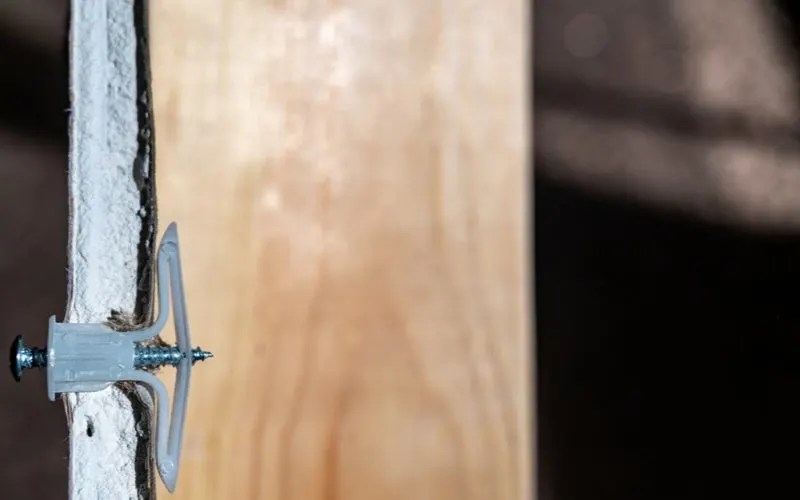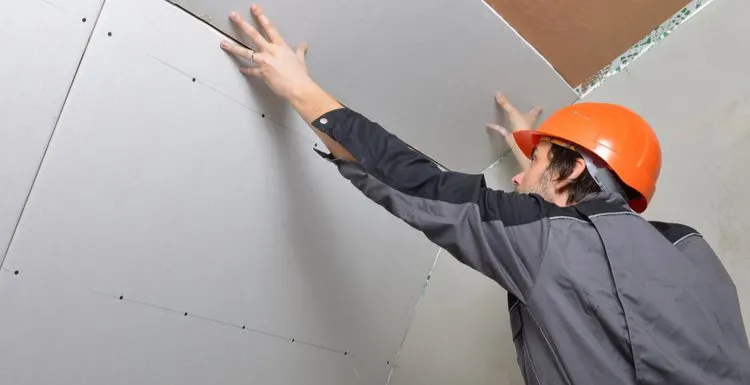As a homeowner, you may be wondering, “How much weight can drywall hold?”
From shelving to plants to everything in between, part of the fun of owning a home is to decorate it however you see fit.
However, the last thing any homeowner wants is to accidentally rip out pieces of their wall from hanging too much weight on their drywall.
That’s why it’s essential to understand how much weight your drywall can hold. From understanding weight maximums to knowing how to adequately anchor items on your drywall, this post covers the ins and outs of hanging weight.
How Much Weight Can Drywall Hold? A Summary

Aleksey Kurguzov/Shutterstock
So, how much weight can drywall hold?
It all depends on what nails and studs you use. With the correct tools, your drywall can handle upwards of 100 pounds of sheer weight (otherwise known as vertical weight).
However, if you use incorrect tools, your drywall can only hold a few pounds at most. Drywall is incredibly thin and brittle.
When only a nail holds up the shelf, painting, mirror, and so forth, the high volume weight drags the nail through the drywall and tears the wall, creating a large hole.
To combat this, homeowners need to use proper anchors and studs to create enough strength to maintain large weights. As for what studs and anchors to use, we’ll detail all that below.
What Is Drywall?
Drywall is a panel of thin gypsum plaster between two sheets of thick paper. Gypsum plaster is a cementing material composed mainly of calcium with strong binding properties.
As a result, gypsum plaster is a terrific material for creating drywall. Because drywall is both fire-resistant, sturdy, and cheap to manufacture, it is a common material used in construction projects and homebuilding.
There are many types of drywall that homeowners can use to customize their homes. These types are:
- Moisture Resistant
- Mold Resistant
- Soundproof
- Extra Fire Resistant
While homeowners can choose plaster that is extra fire-resistant, drywall is always fire-resistant to a degree. This classification is credited because gypsum is a dehydrated material, making it challenging to conduct fire.
Homeowners can also choose how thick they’d like their drywall. For the most part, homeowners can choose between four thickness ranges for their drywall. You can select 1/4 drywall (which is the thinnest drywall on the market)
What Happens When You Rip Drywall?
Sometimes, when you hang too much weight (or weight improperly), it can rip the drywall down, causing massive tears in your wall.
Not only is this unsightly, but it can lead to more significant structural damage within your home.
When holes are present, moisture can soak up into the wall and lead to mold growth. Drywall has a lot of sponge-like qualities, and when there’s a hole or abscess and water gets inside, it can lead to tremendous mold growth.
As a result, you shouldn’t hang too much weight on your drywall, as it will lead to further damage. If you end up with a rip or tear, you must fill it immediately to prevent mold growth.
General Drywall Weight Capacities
Drywall can certainly hold smaller items with no heavy-duty studs. Typically speaking, a one and a half-inch nail can hold roughly 20 pounds. However, you must remember to insert the nail in an upward position to remain in the wall.
Although it may not seem like much, 20 pounds covers a lot of ground.
For those looking to hang a light plant, picture frame, or even a tiny light, you should be able to use a 1 and 1/2 nail without creating any significant damage to your wall.
If you want to nail heavier items onto your drywall, you need to go the next size up and use something a bit more sturdy.
For heavier items, homeowners can use screws. #4 size (or larger) can hold roughly 100 pounds in your drywall. And make sure you use a wall stud when you use a screw.
When you use screws, you must ensure that the screws will go at least 1 inch deep into the stud. If you go deeper than 1 inch, you can damage your screws. If you go less than 1 inch, the screws won’t have a chance to drip on the stud.
Drywall Ceilings
Some homeowners want to hang items from their drywall ceiling. This position is a great way to hang lights, plants, or other decorative items.
However, homeowners must be aware that when you factor in the force of gravity, the typical weight capacity measurements from hanging weight on a wall are much different than the ceiling.
Homeowners shouldn’t use the typical 2×4 ceiling joists if they wish to hang items heavier than 15 pounds. If you are adding something that has movement (like a ceiling fan), you must account for the extra weight that occurs with constant movement.
As a result, you must consider bracing and doubling the joists for any item over 15 or 20 pounds.
You can also add 2×4 blocking between each joist as a way to increase support, but to err on the side of caution, make sure that you always use less weight than you otherwise think is acceptable.
Drywall Anchor and Stud Types

Lost_in_the_Midwest/Shutterstock
Understanding anchor and stud types is paramount to your success when hanging weight on drywall.
Below are the main types of anchors and studs used when nailing weight to your drywall.
Expansion Anchors
Expansion anchors hold the smallest amount of weight (aside from a standard nail).
When used on walls, expansion anchors typically hold between 5 and 25 pounds on walls. One significant feature to consider is that you can’t use these anchors on ceilings.
Threaded Anchors
The next size up is threaded anchors. These anchors are much thicker and sturdier than expansion anchors, and their typical weight capacity is between 25 and 75 pounds.
These anchors shouldn’t be used when hanging items from the ceiling, like expansion anchors.
Sleeve-Type Anchors
Sleeve anchors are a great middle ground. On walls, these anchors can typically hold between 25 and 50 pounds.
They still work on ceilings, but their weight capacity is much smaller. Shockingly, these anchors can only hold items weighing less than 10 ounces (think a carbon monoxide alarm).
Toggle Bolts
These are the most serious, heavy-duty bolts one can buy. If you plan to hang some hefty weight, use toggle bolts for maximum security.
There are two types of toggle bolts: plastic and metal. Metal is the best to use for ceilings.
They are made of metal, which has much more strength than their plastic counterparts and can easily hold up to 100 pounds of weight.
However, this strength doesn’t translate to walls. When used on walls, metal toggles can only handle about 15 pounds of weight. When hanging items vertically on the walls, use plastic toggles.
Things to Consider

Olesia Bilkei/Shutterstock
Remember that not every drywall is similar. Because there are varying thicknesses of drywall, you must consider your size before purchasing any anchors or studs. You also must consider:
- Sheer
- Tension
When hanging items on a wall, you’re not only having nails hold up a weight against a downward pull (sheer) but also a forward pull (tension).
The more tension an item creates (aka, how far out from the wall a thing is), the more strain it puts on your fastener, nail, or stud.
Hanging a bookshelf versus a picture frame calls for two different approaches, and not just because a bookshelf is heavier than a picture frame.
Frequently Asked Questions
Hanging weight on drywall is no easy feat. There are many factors to consider. Many homeowners have varying questions regarding how much weight to put on drywall and how to hang weight on drywall.
Below are some frequently asked questions that many homeowners have regarding hanging items on their drywall:
Can drywall hold 15 pounds?
Yes, drywall can hold 15 pounds of weight, but you’ll want to make sure it’s properly secured with adequate anchors and wall studs. For items that are 15 pounds or less, you should use an expansion anchor instead of a standard nail.
What is the strongest drywall anchor?
While there are several drywall anchors to choose from, the standard metal toggle bolts are undoubtedly the strongest drywall anchors to choose from.
However, these bolts come with their own drawbacks. Primarily, they’re rather tricky to install since you need to drill holes three times wider than the bolt diameter to insert the anchor correctly.
Still, the extra work they require is undoubtedly worth it as you have the utmost peace of mind knowing that you are using the strongest anchors possible.
Can I hang a heavy mirror on drywall?
Yes, you can hang a heavy mirror on drywall. However, you must take proper precautions to ensure that your mirror remains on the wall instead of ripping it off. To achieve this, you need heavy-duty drywall anchors.
You should use molly and toggle bolts to secure heavy items on your wall. Toggle bolts are the best for the heaviest objects, so if your mirror is heavier than 50 pounds, it’s best to only use toggle bolts.
How much weight can drywall hold per square foot?
Generally speaking, drywall can hold roughly 1.5 pounds of weight per square foot. Of course, this depends on the type of drywall you have; thicker drywall can handle heavier loads (up to 2.1 pounds of drywall per square foot).
Can I drill into drywall?
You can drill into drywall, but make sure you steer clear from any outlets. One of the most significant risks of drilling into drywall is accidentally drilling into your homes’ electrical work.
Not only do you risk damaging your home’s electrical circuits, but you also run the risk of getting electrocuted. Additionally, you can accidentally drill into gas and water pipes.
Use extra precaution when drilling into the drywall in your kitchen and bathroom areas. If you’re ever unsure, it’s always best to contact a professional.
So, How Much Weight Can Drywall Hold?
Drywall can hold an incredible amount of weight, so long as you use proper precautions to mount the weight properly. In some cases, you may have to drill into the drywall to place anchors in your walls.
In fact, there are very few cases where a nail will suffice for the amount of weight in drywall. In most cases, you’ll have to drill into the wall and place an anchor inside to prevent the item from ripping your drywall.
However, drilling into your wall comes with other inherent risks (such as electrocuting yourself or damaging your home’s pipes). When in doubt, it’s always best to contact a professional for their advice.

